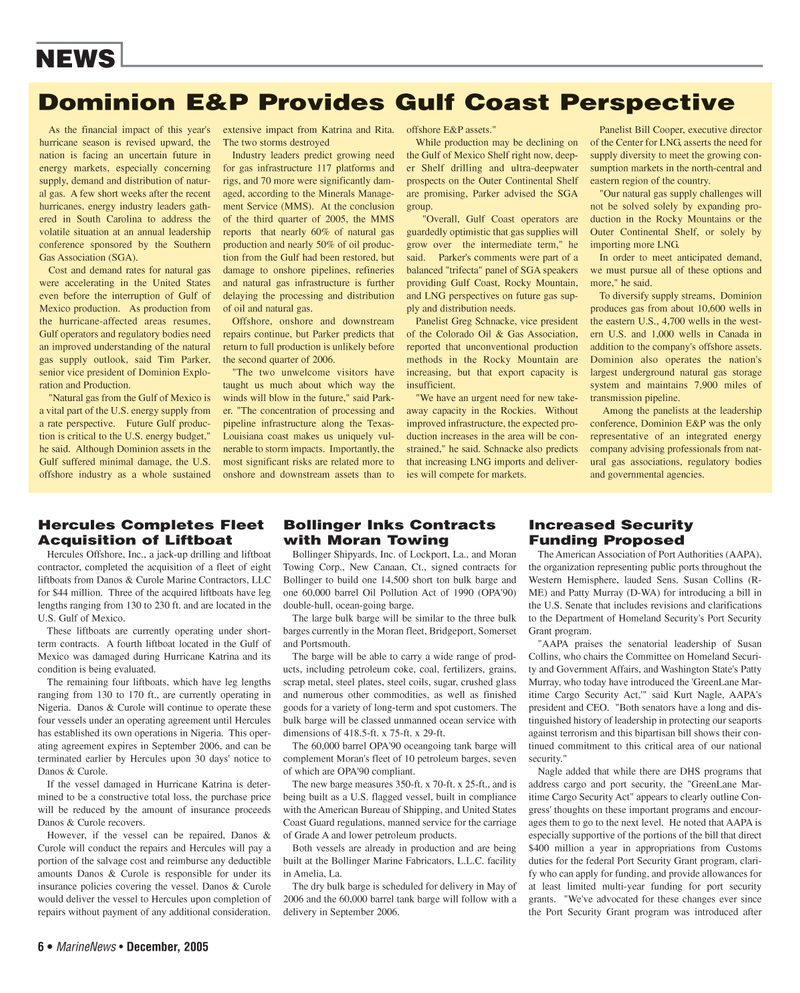
Page 6: of Marine News Magazine (December 2005)
Read this page in Pdf, Flash or Html5 edition of December 2005 Marine News Magazine
Hercules Completes Fleet
Acquisition of Liftboat
Hercules Offshore, Inc., a jack-up drilling and liftboat contractor, completed the acquisition of a fleet of eight liftboats from Danos & Curole Marine Contractors, LLC for $44 million. Three of the acquired liftboats have leg lengths ranging from 130 to 230 ft. and are located in the
U.S. Gulf of Mexico.
These liftboats are currently operating under short- term contracts. A fourth liftboat located in the Gulf of
Mexico was damaged during Hurricane Katrina and its condition is being evaluated.
The remaining four liftboats, which have leg lengths ranging from 130 to 170 ft., are currently operating in
Nigeria. Danos & Curole will continue to operate these four vessels under an operating agreement until Hercules has established its own operations in Nigeria. This oper- ating agreement expires in September 2006, and can be terminated earlier by Hercules upon 30 days' notice to
Danos & Curole.
If the vessel damaged in Hurricane Katrina is deter- mined to be a constructive total loss, the purchase price will be reduced by the amount of insurance proceeds
Danos & Curole recovers.
However, if the vessel can be repaired, Danos &
Curole will conduct the repairs and Hercules will pay a portion of the salvage cost and reimburse any deductible amounts Danos & Curole is responsible for under its insurance policies covering the vessel. Danos & Curole would deliver the vessel to Hercules upon completion of repairs without payment of any additional consideration.
Bollinger Inks Contracts with Moran Towing
Bollinger Shipyards, Inc. of Lockport, La., and Moran
Towing Corp., New Canaan, Ct., signed contracts for
Bollinger to build one 14,500 short ton bulk barge and one 60,000 barrel Oil Pollution Act of 1990 (OPA'90) double-hull, ocean-going barge.
The large bulk barge will be similar to the three bulk barges currently in the Moran fleet, Bridgeport, Somerset and Portsmouth.
The barge will be able to carry a wide range of prod- ucts, including petroleum coke, coal, fertilizers, grains, scrap metal, steel plates, steel coils, sugar, crushed glass and numerous other commodities, as well as finished goods for a variety of long-term and spot customers. The bulk barge will be classed unmanned ocean service with dimensions of 418.5-ft. x 75-ft. x 29-ft.
The 60,000 barrel OPA'90 oceangoing tank barge will complement Moran's fleet of 10 petroleum barges, seven of which are OPA'90 compliant.
The new barge measures 350-ft. x 70-ft. x 25-ft., and is being built as a U.S. flagged vessel, built in compliance with the American Bureau of Shipping, and United States
Coast Guard regulations, manned service for the carriage of Grade A and lower petroleum products.
Both vessels are already in production and are being built at the Bollinger Marine Fabricators, L.L.C. facility in Amelia, La.
The dry bulk barge is scheduled for delivery in May of 2006 and the 60,000 barrel tank barge will follow with a delivery in September 2006.
Increased Security
Funding Proposed
The American Association of Port Authorities (AAPA), the organization representing public ports throughout the
Western Hemisphere, lauded Sens. Susan Collins (R-
ME) and Patty Murray (D-WA) for introducing a bill in the U.S. Senate that includes revisions and clarifications to the Department of Homeland Security's Port Security
Grant program. "AAPA praises the senatorial leadership of Susan
Collins, who chairs the Committee on Homeland Securi- ty and Government Affairs, and Washington State's Patty
Murray, who today have introduced the 'GreenLane Mar- itime Cargo Security Act,'" said Kurt Nagle, AAPA's president and CEO. "Both senators have a long and dis- tinguished history of leadership in protecting our seaports against terrorism and this bipartisan bill shows their con- tinued commitment to this critical area of our national security."
Nagle added that while there are DHS programs that address cargo and port security, the "GreenLane Mar- itime Cargo Security Act" appears to clearly outline Con- gress' thoughts on these important programs and encour- ages them to go to the next level. He noted that AAPA is especially supportive of the portions of the bill that direct $400 million a year in appropriations from Customs duties for the federal Port Security Grant program, clari- fy who can apply for funding, and provide allowances for at least limited multi-year funding for port security grants. "We've advocated for these changes ever since the Port Security Grant program was introduced after 6• MarineNews • December, 2005
NEWS
As the financial impact of this year's hurricane season is revised upward, the nation is facing an uncertain future in energy markets, especially concerning supply, demand and distribution of natur- al gas. A few short weeks after the recent hurricanes, energy industry leaders gath- ered in South Carolina to address the volatile situation at an annual leadership conference sponsored by the Southern
Gas Association (SGA).
Cost and demand rates for natural gas were accelerating in the United States even before the interruption of Gulf of
Mexico production. As production from the hurricane-affected areas resumes,
Gulf operators and regulatory bodies need an improved understanding of the natural gas supply outlook, said Tim Parker, senior vice president of Dominion Explo- ration and Production. "Natural gas from the Gulf of Mexico is a vital part of the U.S. energy supply from a rate perspective. Future Gulf produc- tion is critical to the U.S. energy budget," he said. Although Dominion assets in the
Gulf suffered minimal damage, the U.S. offshore industry as a whole sustained extensive impact from Katrina and Rita.
The two storms destroyed
Industry leaders predict growing need for gas infrastructure 117 platforms and rigs, and 70 more were significantly dam- aged, according to the Minerals Manage- ment Service (MMS). At the conclusion of the third quarter of 2005, the MMS reports that nearly 60% of natural gas production and nearly 50% of oil produc- tion from the Gulf had been restored, but damage to onshore pipelines, refineries and natural gas infrastructure is further delaying the processing and distribution of oil and natural gas.
Offshore, onshore and downstream repairs continue, but Parker predicts that return to full production is unlikely before the second quarter of 2006. "The two unwelcome visitors have taught us much about which way the winds will blow in the future," said Park- er. "The concentration of processing and pipeline infrastructure along the Texas-
Louisiana coast makes us uniquely vul- nerable to storm impacts. Importantly, the most significant risks are related more to onshore and downstream assets than to offshore E&P assets."
While production may be declining on the Gulf of Mexico Shelf right now, deep- er Shelf drilling and ultra-deepwater prospects on the Outer Continental Shelf are promising, Parker advised the SGA group. "Overall, Gulf Coast operators are guardedly optimistic that gas supplies will grow over the intermediate term," he said. Parker's comments were part of a balanced "trifecta" panel of SGA speakers providing Gulf Coast, Rocky Mountain, and LNG perspectives on future gas sup- ply and distribution needs.
Panelist Greg Schnacke, vice president of the Colorado Oil & Gas Association, reported that unconventional production methods in the Rocky Mountain are increasing, but that export capacity is insufficient. "We have an urgent need for new take- away capacity in the Rockies. Without improved infrastructure, the expected pro- duction increases in the area will be con- strained," he said. Schnacke also predicts that increasing LNG imports and deliver- ies will compete for markets.
Panelist Bill Cooper, executive director of the Center for LNG, asserts the need for supply diversity to meet the growing con- sumption markets in the north-central and eastern region of the country. "Our natural gas supply challenges will not be solved solely by expanding pro- duction in the Rocky Mountains or the
Outer Continental Shelf, or solely by importing more LNG.
In order to meet anticipated demand, we must pursue all of these options and more," he said.
To diversify supply streams, Dominion produces gas from about 10,600 wells in the eastern U.S., 4,700 wells in the west- ern U.S. and 1,000 wells in Canada in addition to the company's offshore assets.
Dominion also operates the nation's largest underground natural gas storage system and maintains 7,900 miles of transmission pipeline.
Among the panelists at the leadership conference, Dominion E&P was the only representative of an integrated energy company advising professionals from nat- ural gas associations, regulatory bodies and governmental agencies.
Dominion E&P Provides Gulf Coast Perspective
DECEMBER MN2005 1(1-8).qxd 12/5/2005 3:17 PM Page 6

 5
5

 7
7
